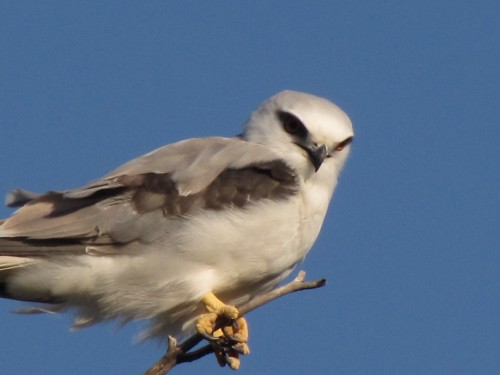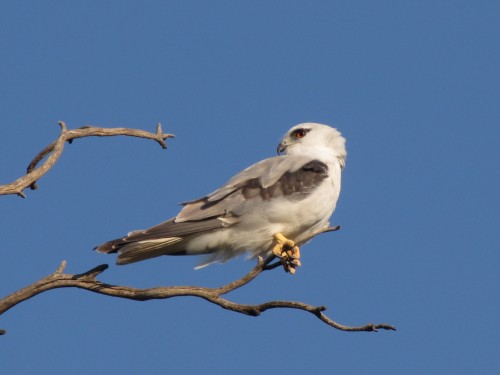Black-shouldered Kite
One of the species we often have visiting our garden, or soaring overhead, is the Black-shouldered Kite, shown in today’s photos. Over recent weeks we have had frequent visits by an individual displaying juvenile plumage. This is not the first time that this species has been observed breeding in the vicinity of our home.
Yesterday’s visit proved fruitful for me. Normally the bird will perch on the dead branch at the top of a mallee tree at the house. This gives it a good view all around. Usually, when I creep outside with my camera it flies off immediately, much to my annoyance and frustration. Yesterday was different; it posed for my camera while I took about 20 photos. Great – especially with the deep blue summer sky as a backdrop.
It wasn’t allowed to perch there unchallenged for long. I noticed that the resident White-plumed honeyeaters were chirping their warnings to all around, and the Red Wattlebird (shown below) was brave enough to actually swoop the kite and snap its beak nearby. Eventually the harassment was too annoying, and the kite flew off.
If you enjoyed this article, you might enjoy reading the following:
- Brown Falcon at Monarto Zoo
- Wedge-tailed eagle overhead
- Black Kite, Mannum
- Surprised by a kite – a humorous encounter with a Yellow-billed Kite in Ethiopia
The chase is on
A little while ago I was outside in the garden attending to one of those mundane jobs around the house. Okay, I’ll admit I was checking the washing hanging out to dry. My attention was suddenly grabbed by a great uproar coming from the local resident honeyeaters. They were creating a terrible noise, so I knew that something was disturbing them big time.
As I looked around a Collared Sparrowhawk (see photo above) landed on the power line coming in towards the house. Next thing, it took off after its lunch – a Common Starling. Well, I’m not sure if it actually caught its prey. The last I saw of them was the starling zooming a full speed across the garden and then weaving through the mallee scrub behind our house, hotly pursued at full speed by the hawk. I was amazed at how fast they were going, but when you consider those sharp talons, one can hardly blame the starling for getting a move on.
Murder in the garden
Many people enjoy seeing birds, especially those that visit their gardens. People also enjoy seeing birds in parks and reserves, on the beach or along rivers. They are variously described as “cute”, “pretty”, “delightful”, “wonderful” and many other such “nice” words.
Rarely are they described as gory, or brutal or even dangerous. The stark reality is that while many birds are indeed stunning in their colours, amazing in their survival instincts and quite fascinating in their behaviour, some species do have a gory, brutal (in human terms) side to their lives.
A few days ago I was hanging up the washing on the clothes line – or getting it off – whatever – and there was a sudden noisy kerfuffle in the trees nearby. The various honeyeater species were totally upset – and with good reason. A Collared Sparrow-hawk flew ponderously to a branch nearby, clutching a struggling bird in its talons.
The sparrow-hawk proceeded to gouge chunks of flesh off the hapless bird, feathers scattering in the breeze and all the while the rest of the avian community voiced their disapproval – or fears. I tried to sneak up for a closer look. I quickly dismissed the idea of racing inside to get the camera. It appeared to be a White-plumed Honeyeater being eaten.
This is the reality of life in the raw. To survive, the sparrow-hawk must eat. One bird’s death means another bird’s survival. In human terms it seems cruel and gory, but this is the way of web of life.
I didn’t get a photo, so I’ve included one below that I took some years ago.
This article was last update on 10th October 2015.
Common Kestrel, Rabat, Morocco
During our brief visit to Rabat in Morocco I had a few opportunities to do some incidental birding as we travelled around, and particularly whenever we went walking anywhere. At one spot next to the coast I saw the Common Kestrel shown in the photo above.
The photo is not a very good one as the bird was quite some distance away and for once the zoom on my camera let me down a little; the closer shots are somewhat blurry. It the photo above, the bird is looking down towards the water and rocks below. In the photo below I’ve zoomed out to show the location and general habitat of this particular bird.
Angry birds in our garden
Last week I wrote about the young Grey Currawongs being fed by the adults in our garden. They are still hanging around and squawking noisily whenever they get hungry – which seems to be most of the time.
Yesterday morning I was doing some reading in our sun room when a sudden screeching noise outside interrupted my thoughts. I grabbed the binoculars (but not the camera, alas) and raced outside. High up in the sky above our house a Little Eagle was soaring around on the gentle breeze, obviously looking for something to eat for lunch.
The eagle seemed oblivious to the fact that both currawong parents were attacking it, screeching loudly in order to chase away the offending predator. Slowly, almost nonchalantly, the eagle glided away out of sight and the currawongs calmed down and resumed feeding the young ones., and peace resumed in the garden.
More angry birds
The currawongs are not the only angry birds resident in our garden. The Australian Magpies chase off the Grey Currawongs and the White-winged choughs, the Willie Wagtails are constantly attacking all three already mentioned and the Red Wattlebirds appear to have a distinct dislike towards anything with wings, including the hapless tiny Pardalotes. This latter conflict is a real miss-matched war: wattlebirds are bout 36cm long compared with the pardalotes weighing in at only 8cm. I reckon the wattlebirds are the big bullies in our little patch.








